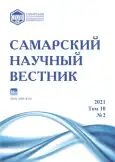New segetal communities of sunflower crops in the Orenburg Region
- Authors: Yamalov S.M.1, Khasanova G.R.2, Lebedeva M.V.1, Korchev V.V.1
-
Affiliations:
- South-Ural Botanical Garden-Institute of the Ufa Federal Research Centre of Russian Academy of Sciences
- Bashkir Research Institute of Agriculture of the Ufa Federal Research Centre of Russian Academy of Sciences
- Issue: Vol 10, No 2 (2021)
- Pages: 124-130
- Section: General Biology
- URL: https://journals.rcsi.science/2309-4370/article/view/78107
- DOI: https://doi.org/10.17816/snv2021102119
- ID: 78107
Cite item
Full Text
Abstract
The diversity of weed-field communities of sunflower crops within the forest-steppe zone of the Orenburg Region (Abdulinskiy, Matveevskiy, Oktyabrskiy, Aleksandrovskiy, Sharlykskiy districts) was studied. The communities in the system of ecological-floristic classification units are assigned to the new variant Orobanche cumana of the Amarantho blitoides – Lactucetum tataricae Khasanova et al. 2019. In the core of the cenoflora of communities juvenile weed species prevail. The most active of them are late spring annuals (Amaranthus blitoides, Panicum miliaceum, Amaranthus retroflexus, Setaria viridis) and early spring annuals (Chenopodium album, Fallopia convolvulus, Camelina microcarpa). Root perennials such as Lactuca tatarica, Convolvulus arvensis, Euphorbia virgata, Cirsium arvense have also a high proportion. A distinctive feature of the communities is the participation in their floristic composition of a dangerous quarantine species – Sunflower broomrape (Orobanche cumana). Modeling the area of the association under a moderate scenario of climate change shows that the distribution of communities by 2050 can cover almost the entire territory of the Cis-Urals (within the Republic of Bashkortostan). It is necessary to organize a monitoring system for the range of these communities in the Southern Urals.
Full Text
##article.viewOnOriginalSite##About the authors
Sergey Maratovich Yamalov
South-Ural Botanical Garden-Institute of the Ufa Federal Research Centre of Russian Academy of Sciences
Email: yamalovsm@mail.ru
doctor of biological sciences, leading researcher of Wild-Growing Flora and Herbasceous Plants Introduction Laboratory
Russian Federation, UfaGulnaz Rimovna Khasanova
Bashkir Research Institute of Agriculture of the Ufa Federal Research Centre of Russian Academy of Sciences
Email: gulnazrim@yandex.ru
candidate of biological sciences, senior researcher of Crop Production, Agriculture and Soil Fertility Laboratory
Russian Federation, UfaMaria Vladimirovna Lebedeva
South-Ural Botanical Garden-Institute of the Ufa Federal Research Centre of Russian Academy of Sciences
Email: lebedevamv@mail.ru
candidate of biological sciences, senior researcher of Tropical and Subtropical Plants Group
Russian Federation, UfaVladimir Vladimirovich Korchev
South-Ural Botanical Garden-Institute of the Ufa Federal Research Centre of Russian Academy of Sciences
Author for correspondence.
Email: gistivinur@mail.ru
researcher of Wild-Growing Flora and Herbasceous Plants Introduction Laboratory
Russian Federation, UfaReferences
- Миркин Б.М., Наумова Л.Г. Современное состояние основных концепций науки о растительности. Уфа, 2012. 488 с.
- Ямалов С.М., Лебедева М.В., Лунева Н.Н., Хасанова Г.Р., Шигапов З.Х. Сравнительная характеристика факторов организации сегетальных сообществ Ленинградской области и Республики Башкортостан // Самарский научный вестник. 2019. Т. 8, № 3 (28). С. 92–98. doi: 10.17816/snv201983116.
- Хасанова Г.Р., Ямалов С.М., Лебедева М.В., Шигапов З.Х. Сегетальная растительность Южного Урала: союзы Caucalidion Tx. ex von Rochow 1951 и Lactucion tataricae Rudakov in Mirkin et al. 1985 // Растительность России. 2019. № 37. С. 118–134.
- Третьякова А.С., Баранова О.Г., Лунева Н.Н., Терехина Т.А., Ямалов С.М., Лебедева М.В., Хасанова Г.Р., Груданов Н.Ю. Сегетальная флора некоторых регионов России: характеристика таксономической структуры // Труды по прикладной ботанике, генетике и селекции. 2020. Т. 181, № 2. С. 123–133.
- Хасанова Г.Р., Ямалов С.М., Лебедева М.В., Сафин Х.М. Прогноз распространения сорно-полевых сообществ Южного Урала на основе климатического моделирования // Достижения науки и техники АПК. 2018. Т. 32, № 9. С. 17–20.
- Хасанова Г.Р., Ямалов С.М., Лебедева М.В., Голованов Я.М. О новой ассоциации сегетальной растительности Южного Урала // Самарский научный вестник. 2019. Т. 8, № 4 (29). С. 97–103. doi: 10.17816/snv201984117.
- Энциклопедия «Оренбуржье». Т. 1. Природа. Калуга: Золотая аллея, 2000. 192 с.
- Географический атлас Оренбургской области. М.: Изд-во «ДИК», 1999. 96 с.
- Hennekens S.M., Schaminée J.H.J. TURBOVEG, a comprehensive data base management system for vegetation data // Journal of Vegetation Science. 2001. Vol. 12, № 4. P. 589–591. doi: 10.2307/3237010.
- Tichý L. JUICE, software for vegetation classification // Journal of Vegetation Science. 2002. Vol. 13. P. 451–453.
- Theurillat J.-P., Fernández-González F., Bültmann H., Čarni A., Gigante D., Mucina L., Weber H. International code of phytosociological nomenclature. 4th edition // Applied Vegetation Science. 2020. Vol. 24 (1). P. 1–62. doi: 10.1111/avsc.12491.
- Mucina L., Bültmann H., Dierßen K., Theurillat J.-P., Raus T., Čarni A., Šumberová K., Willner W., Dengler J., Gavilán García R., Chytrý M., Hájek M., Di Pietro R., Iakushenko D., Pallas J., Daniëls F.J.A., Bergmeier E., Santos Guerra A., Ermakov N., Valachovič M., Schaminée J.H.J., Lysenko T., Didukh Ya.P., Pignatti S., Rodwell J.S., Capelo J., Weber H.E., Solomeshch A., Dimopoulos P., Aguiar C., Hennekens S.M., Tichý L. Vegetation of Europe: hierarchical floristic classification system of vascular plant, bryophyte, lichen, and algal communities // Applied Vegetation Science. 2016. Vol. 19, suppl. 1. P. 3–264. doi: 10.1111/avsc.12257.
- Phillips S.J., Dudik M. Modeling of species distributions with Maxent: new extensions and a comprehensive evaluation // Ecography. 2008. Vol. 31. P. 161–175.
- Title P.O., Bemmels J.B., ENVIREM: an expanded set of bioclimatic and topographic variables increases flexibility and improves performance of ecological niche modeling // Ecography. 2018. Vol. 41. P. 291–307.
- Мулдашев А.А., Абрамова Л.М., Голованов Я.М. Конспект адвентивных видов растений Республики Башкортостан. Уфа, 2017. 168 с.
Supplementary files










